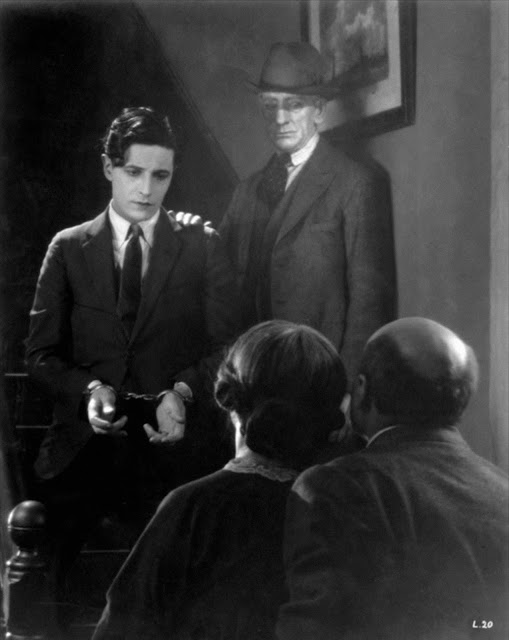Date Seen: 4/27/17
Score: 5/5
DIRECTOR: Alfred Hitchcock
PRODUCERS: Michael Balcon, Carlyle Blackwell, and C.M. Woolf
STUDIO: Gainsborough Pictures
SCREENPLAY: Eliot Stannard
CINEMATOGRAPHY: Gaetano di Ventimiglia
 |
| Ivor Novello |
 |
| Ivor Novello, The Lodger himself, stands in front of a window and has the shadow of the panes reflect onto his face in the film's most famous allusion to Christ- also a clever vision indication of his innocence |
 |
| Marie Ault |
 |
| "To-night: Golden Curls" |
 |
| June Tripp |
 |
| Ivor Novello and June Tripp |
 |
| June Tripp in a fabulous example of what pre-code films could show |
 |
| Some of Hitchcock's first blondes |
 |
| June Tripp and Ivor Novello |
 |
| June Tripp and Ivor Novello |
 |
| From left: A police detective (uncredited), The Lodger (Ivor Novello), Daisy (June Tripp), and Joe (Malcolm Keen) |
 |
| Ivor Novello acting out what Hitchcock later likened to a Crucifixion- just one of several of the film's visual allusions to Christ |
 |
| Ivor Novello and June Tripp |
 |
| From left: Mrs. Bunting (Marie Ault), Daisy (June Tripp), and Mr. Bunting (Arthur Chesney) |
 |
| The film's opening shot |
To say I love Alfred Hitchcock's 1927 silent film The Lodger is an understatement. It might actually be my favorite Hitchcock film. I was intrigued by the film before I was able to see it after reading that Hitchcock used a glass floor to show the mysterious Lodger pacing above the heads of his suspicious landlords without the ability to use sound. Here are two shots of this ingenious and innovative early film technique:


The Lodger is an incredible film, and I don't just say that because I think that Ivor Novello is probably the most attractive man ever to star in a Hitchcock film, or any film, actually. The Lodger allows a young Hitchcock to experiment with cinematic tools, and practice the kind of visual innovation he would become famous for in the decades to come. Certainly we can credit The Lodger and Hitchcock's other silent films with giving him the platform to express crucial information through the image. Hitchcock relies heavily on images to represent plot development in his films- for a perfect example, watch the opening scene of Rear Window- and silent movies put him at no disadvantage, perhaps even emphasizing his talent at visually transferring information to the viewer.
There are two particularly significant aspects of this film. First of all, the plot, while certainly not the most complex or far-fetched of his storylines, leaves the viewer suspended in doubt regarding the innocence of Ivor Novello's Lodger in the Jack the Ripper-esque crime spree that's been sweeping London, and Hitchcock uses subtle but powerful visual allusions to Jesus Christ in an effort to hint to viewers that the Lodger is, in fact, innocent. From the shot of Novello standing in front of a window with shadows superimposing a cross onto his face to a later scene in which he is suspended from a fence with his arms outstretched, as though he is being wrongly crucified by an angry mob, Hitchcock inserts several references to Christ, all suggesting, despite the protagonist's mystery and the very well-grounded case against him, that he is innocent.
The second important aspect of the film is its position as an excellent precursor to later Hitchcock films. Whereas in several of Hitchcock's early films he uses techniques, storylines, and directorial tools that he later discredits, The Lodger is a great example of an early film that encompasses many motifs that Hitchcock would continue to employ, many of which becoming signatures of his films. Certainly his obsession with blondes is introduced in this film, and even darkly joked at, as if the fates of the doomed blondes in The Lodger is a foreshadowing of what is to come for later blondes, from Kim Novak in Vertigo to Tippi Hedren in The Birds.
Another signature motif introduced is the incompetent police force, personified by Malcolm Keen's arrogant, annoying Joe Chandler, a police officer assigned to work on the murder cases whose personal vendetta against the Lodger verbally indicts him for the crimes, nearly resulting in his death at the hands of an angry mob. While, thankfully, Chandler realizes the man's innocence at the end of the film and comes to his rescue at the last minute (as if that would really happen), his presence in the film is one of the first examples of Hitchcock's tendency to include a police presence that either fails to protect the public (Shadow of a Doubt, Psycho, Dial M For Murder, Strangers on a Train, Rear Window, The Man Who Knew Too Much), or, in this case, purposefully and knowingly sabotages the innocent (also seen in Vertigo, The Lady Vanishes, and, to a certain extent, in The Birds).
I adore this film, and thoroughly encourage you to watch it if you're a Hitchcock fan who's never seen it. You'll be delighted to pick up on some famous Hitchcock themes in their early stages of development, and also just to sit back and enjoy Ivor Novello being incredibly sexy.




















No comments